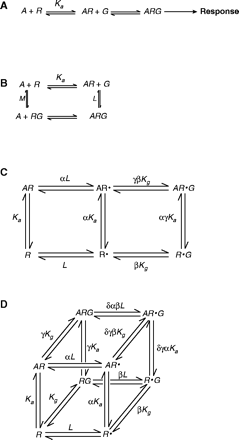
- Institution: Stanford Univ Med Ctr Lane Med Lib/Periodical Dept/Rm L109
- Sign In as Member / Individual
The Receptor Concept: A Continuing Evolution

Evolution of models describing the coupling of GPCRs to G proteins. A. The earliest models of signaling evoked by GPCRs were linear, with a single receptor, upon agonist occupancy, binding to and activating a G protein, which then activated a downstream signaling pathway. B. The Ternary Complex Model (TCM); (47–48) described a relationship between receptor affinity for agonist (Ka) and receptor affinity for G (Kg), the G protein, both regulated by GTP. C. The Extended Ternary Complex Model (ECM) (49) allows for the receptor to spontaneously isomerize to an active state, R*, or to couple to G in the absence of ligand. The cooperativity factors (e.g., α, β) modify the isomerization constant, L, as well as the equilibrium association constants (Ka and Kg ) when these isomerizations occur for receptor occupied either by agonist or inverse agonist. D. The Cubic Ternary Complex Model (50), allows for the existence of inactive ARG complexes. Another cubic model (51) allows for active and inactive receptor states with no G protein coupling, and can be adapted for modeling allosteric modulation of GPCRs by small molecules, rather than by interaction with G proteins (52). Panel B modified from (48) and panels C and D modified from (52).
This Article
-
MI December 2004 vol. 4 no. 6 326-336


